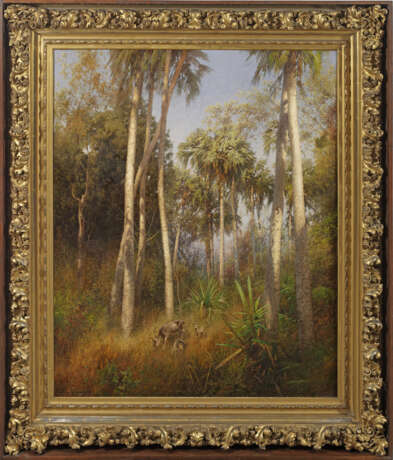ID 219871
Lot 1533 | Hermann Ottomar Herzog
Große Florida-Landschaft in den Everglades
Blick auf eine lichtdurchflutete Landschaft mit Rehen unter Palmen. Großformatiges Hauptwerk des bedeutenden deutsch-amerikanischen Malers, der zur Hudson River School gehörte. Herzog besuchte ab 1849 die Akademie in Düsseldorf, wo er 1851-1854 bei Johann Wilhelm Schirmer und Rudolf Wiegmann studierte. Außerdem nahm er Privatunterricht bei Andreas Achenbach und Hans Fredrik Gude. Von 1854 bis 1871 gehörte er dem Künstlerverein Malkasten an. Ende der 1860er Jahre wanderte er in die USA aus und wurde in Philadelphia als Landschaftsmaler ansässig. Danach unternahm er weite Studienreisen durch die USA und Mexiko, insbesondere die westlichen Bundestaaten, Kalifornien mit dem Yosemite-Tal (1873) und Maine. Nicht zuletzt bereiste er oftmals Florida, wo ihn die exotische, tropische Landschaft mit ihren Sümpfen und hochaufragenden Palmen faszinierte. 1876 wurde er auf der ersten Weltausstellung in den USA (Centennial Exhibition) in Philadelphia für eine Ansicht des Sentinel Rock im Yosemite Tal ausgezeichnet. Als umsichtiger Geschäftsmann war Herzog nicht auf den Verkauf seiner Kunstwerke angewiesen, um einen komfortablen Lebensstil aufrechtzuerhalten. Daher kamen viele Werke seines rund 1000 Gemälde umfassenden Oeuvres erst in den 1970er Jahren aus dem Besitz der Familie auf den Kunstmarkt. Eine Reihe bekannter Museen in Europa und besonders den USA besitzen inzwischen Werke Herzogs in ihren Sammlungen - neben dem Metropolitan Museum of Art in New York u. a. im Smithsonian American Art Museum in Washington, Museum of Fine Arts in Boston und Cincinnati Art Museum in Ohio. Öl/Leinwand, doubliert; Signatur; 156 cm x 134 cm. Rahmen.
Provenienz: Alte europäische Privatsammlung.
Oil on cancas, relined. Signed.
| Address of auction |
Kunstauktionshaus Schloss Ahlden GmbH Große Str. 1 29691 Ahlden(Aller) Germany | ||||||||||||||
|---|---|---|---|---|---|---|---|---|---|---|---|---|---|---|---|
| Preview |
| ||||||||||||||
| Phone | +49 5164 80100 | ||||||||||||||
| Buyer Premium | 25.0 | ||||||||||||||
| Conditions of purchase | Conditions of purchase | ||||||||||||||
| Business hours | Business hours
|




